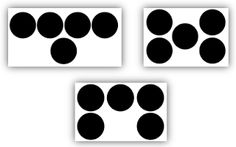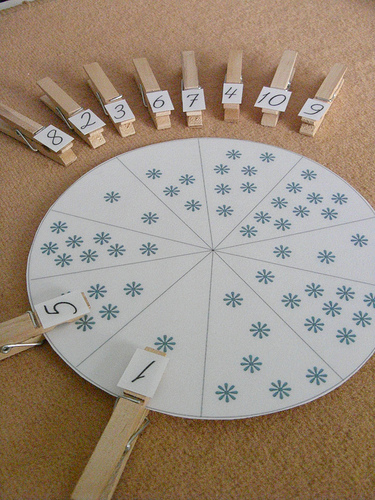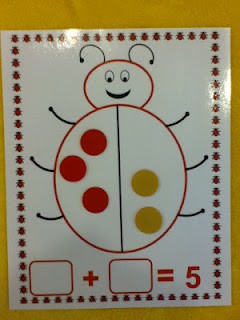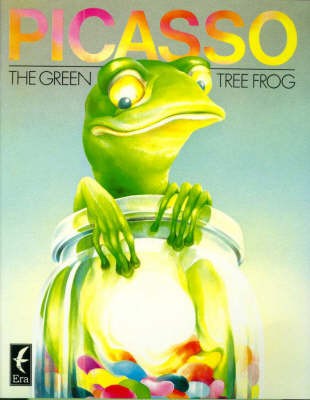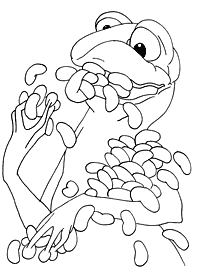So let's teach Subitizing!
-Emily Bolin
Subitizing, as we have encountered previously, is a crucial area for children learning early numeracy to develop (Reys et al., 2012). AusVELS stresses that at foundation level students should display the ability to 'subitise small collections of objects (ACMNA003)' (VCAA, 2014). Teachers need to provide students with ample opportunity during their early education to extend number sense and improve their outcomes within Numeracy (Howell et al., 2010). Subitizing thus is increasingly important for teachers to implement effectively in early numeracy. There are many exciting methods of utilising this key skill within the classroom.
Dot cards are a popular choice for the aspiring Subitizing teacher. Dot cards show groupings of black dots on a card, an examples shown here:
Dot cards are a popular choice for the aspiring Subitizing teacher. Dot cards show groupings of black dots on a card, an examples shown here:
This simple resource can be used in diverse ways. One use of these is to make a flipbook with dot cards. One can then flash dot cards at a child and quickly hide them again. To see the activity being played out, please watch the video and observe the way the task gives space for the child to reason and explain their thinking, a perfect way to assess their Subitizing ability.
However, you can take Subitizing further. It is important to positively engage children during lessons (Roffey, 2004). With this in mind, when teaching Subitizing to your students you may want to take Subitizing further than simply flashing dot cards. There are lots of ways to break this mould. Resources such as a DIY counting rope can be a great way to flash these random quantities whilst thinking outside the box.
Another interesting activity that conveys a keen sense of Subitizing is creating and implementing a Subitizing wheel. Each wedge of this wheel has a different amount shown in a group. Little pegs have been made with the actual numerical value printed. Students have to peg the correct number to the correct array shown. This is great because it is a tactile task that allows ample opportunity for student involvement, without making students speak up which shy children may be hesitant in doing. The wheel is shown here:
|
Activities that are playful, or that involve engagement with personal experience and prior knowledge can aid the learning process (Reys et al., 2012). Familiar and fun objects can be a way to draw young students in- such as seen within the following lady bug worksheet. As you can see to the left, the lady bug shown on the worksheet has two wings, and a certain grouping of spots on each one. Below it shows two empty boxes, and an equals sign, followed by a shown answer. The task gets students to explore their mathematical thinking, such as processing which two numbers make the end result, whilst also testing their Subitizing. The playful use of a lady bug makes the activity a little more interesting to students than simple dot cards. Additionally worthy of note is that by laminating such worksheets students can use whiteboard markers to write their answer in a non obtrusive way, thereby enabling them have a go and better enabling the learning of Subitizing. |
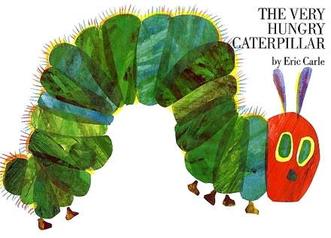
Picture books can enhance children's understanding of numeracy (McMath et al., 1994). They are innately engaging and help students connect with the reader in a meaningful way and learn without even being aware of the educational content of what they are absorbing. They also can be a good lead in for follow up activities. It is a good idea to actively use picture books as a means of teaching Subitizing in your classroom.
Some suggestions of exciting picture books you could use are as follows.
The Very Hungry Caterpillar- Eric Carle.
This beautiful picture book tells the story of a caterpillar that eats first one apple, then two pears, and so forth. The objects are shown on each page, lined up, and children greatly enjoy the counting and increasing value, and the suspense that comes with this. This would be a great warm up to any mathematical activity- in this case, Subitizing. To adapt it to Subitizing during the first reading you could ask kids, before counting together, how much fruit they see? You will be able to see those who need to count, and those who can gauge it just by looking. Closing the book quickly after having asked the question can aid this as well to ensure they do not count. Follow up questions of "how did you know?" will enable you to assess their thinking. After the reading, you could easily do a follow up activity. You could integrate with arts and crafts, and get students to create their own fruit- and then collect up the fruit, arrange them in small amounts and ask them to guess how many there are without counting. Alternatively, you could simply make worksheets with different amounts of fruits and get them to write the numerical value in a small box adjacent. I feel the mathematical potential of this book allows many ways to ignite the imagination of teacher and student alike during a Subitizing focus.
The caterpillar not your style?
Many books can be adapted to suit your individual Numeracy lessons. For an example of how to turn any book into a Subitizing opportunity, take this following example.
Picasso the Green Tree Frog - Amanda Graham.
Some suggestions of exciting picture books you could use are as follows.
The Very Hungry Caterpillar- Eric Carle.
This beautiful picture book tells the story of a caterpillar that eats first one apple, then two pears, and so forth. The objects are shown on each page, lined up, and children greatly enjoy the counting and increasing value, and the suspense that comes with this. This would be a great warm up to any mathematical activity- in this case, Subitizing. To adapt it to Subitizing during the first reading you could ask kids, before counting together, how much fruit they see? You will be able to see those who need to count, and those who can gauge it just by looking. Closing the book quickly after having asked the question can aid this as well to ensure they do not count. Follow up questions of "how did you know?" will enable you to assess their thinking. After the reading, you could easily do a follow up activity. You could integrate with arts and crafts, and get students to create their own fruit- and then collect up the fruit, arrange them in small amounts and ask them to guess how many there are without counting. Alternatively, you could simply make worksheets with different amounts of fruits and get them to write the numerical value in a small box adjacent. I feel the mathematical potential of this book allows many ways to ignite the imagination of teacher and student alike during a Subitizing focus.
The caterpillar not your style?
Many books can be adapted to suit your individual Numeracy lessons. For an example of how to turn any book into a Subitizing opportunity, take this following example.
Picasso the Green Tree Frog - Amanda Graham.
This book tells the story of a green tree frog who, upon encountering a jar of jellybeans, soon becomes multicoloured. In order to make himself green again, he must eat different amounts of jellybeans to return to normal. In particular the page in which he eats these different amounts I would focus on, shown here as a blank image with which one can make an activity/worksheet.
In the above image you see a blank version of a page of the book, a key plot point and a perfect place to adapt the book for Subitizing. You would hand out a copy of this image in A4 size to students, and ask them to colour different amounts of the jellybeans different colours. For example, one child may colour three yellow, two red, five pink, six brown, etc.
After having collected finished worksheets the teacher could flash them at the whole class- giving students opportunity to Subitize their own work, which I think would be engaging and a valuable learning experience.
Thus any picture book that shows different amounts of objects could be played with in follow up activities, to keep the learning experience fresh and engaging.
There are lots of exciting resources out there on the internet to use in your classroom when tackling Subitizing. Videos such as the one below are a great way to flash quantities to the children to get them to guess. They can chant out the answer- this way students won't be too intimidated to answer and can be a lead up to individual assessment.
In short, the main thing the teacher should be able to take away from this is the idea that Subitizing can be an engaging and fun experience for both student and teacher- and that, by using diverse resources and different methods, this important mathematical concept can be solidified in the minds of those learning early numerical knowledge.
Some of these activities were created by others; to see these activities on their original source, or to see more that they have to offer, please consult the following pages:
http://love2learn2day.blogspot.com.au/2012/04/subitizing-making-sense-of-numbers.html.
http://yourmathwizard.weebly.com/number-sense.html
http://yourmathwizard.weebly.com/number-sense.html
